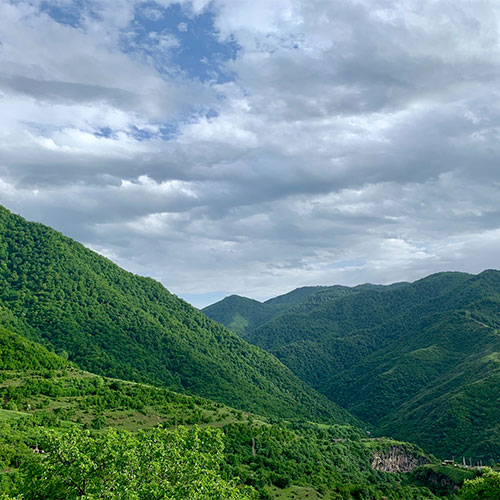Information about Armenia’s commitments under the Paris Agreement

Armenia ratified the UNFCCC in 1993 and the Kyoto Protocol in 2002. The RA National Assembly ratified the Paris Agreement and the Doha Amendment to Kyoto Protocol on February 8, 2017. Obligations of the Republic of Armenia within the framework of the aforementioned international multilateral instruments derive from the status of a developing country acting as a non-Annex I party to the UNFCCC. The country's position under the Convention and the Paris Agreement is set out in the “Intended Nationally Determined Contributions” document (INDC), approved by the GoA Protocol Decree No. 41, from 10 September 2015, and submitted to UNFCCC on September 22, 2015.
The Republic of Armenia stated its position on the limitation of greenhouse gas emissions in subsequent national communications to the UNFCCC and in the Republic of Armenia’s Statement on Association with Copenhagen Accords:

1. In relation to low carbon development Armenia describes the term “fairness” by applying the UNFCCC definition of “common, but differentiated responsibility”, which considers the different levels of historical responsibility among countries in contributing to the increase of greenhouse gas concentration in the atmosphere, leading to climate change.
2. The climate change mitigation actions should not reverse the social and economic trends but contribute to the socio-economic development of the Republic of Armenia. These actions must be based on an “ecosystem approach”, which is preferred by the Republic of Armenia, since it allows maximizing the synergies between mitigation and adaptation actions in most sectors of the economy, facilitating fair regional cooperation and contributing to solidarity.
In accordance with INDC document, the total aggregate quantitative contribution of the Republic of Armenia is equal to 633 million tons carbon dioxide equivalent (189 tons per capita x 3.35 million people) for the period of 2015-2050 or an annual average of 5.4 tons per capita. In 2010, Armenia’s GHG emissions comprised 2.14 tons per capita. The Republic of Armenia strives to achieve ecosystem neutral GHG emissions by 2050 (2.07 tons/per capita annual) with the support of adequate (necessary and sufficient) international financial, technological and capacity building assistance. In case of non-exceeding its total emissions quota (633 million tons) set for the period of 2015-2050 Armenia can credit non-utilized reduction to “carbon market” or transfer it to the balance of emissions limitation envisaged for the period of 2050-2100.

The main sectors included in the mitigation contribution are:
• Energy (including renewable energy and energy efficiency;
• Transport (including development of electrical transport)
• Urban development (including buildings and construction);
• Industrial processes (construction materials and chemical production);
• Waste management (solid waste, wastewater, agricultural waste);
• Land use and Forestry (afforestation, forest protection, carbon storage in soil);
Consider 20.1% as an optimal forest cover indicator of the territory of the Republic of Armenia according to the Armenia`s First National Communication to UNFCCC (1998) and Government Decision No 1232 of 21 July 2005 “On Adoption of the National Forest Program of the Republic of Armenia”. To achieve that indicator by 2050 and consider the obtained organic carbon absorptions and accumulations in the INDC and expand the impact period up that measure until 2100.
Ensure organic carbon conservation, accumulation and storage in all categories of lands through comprehensive measures and include achieved balance in the INDC. Apply the Nationally Appropriate Mitigation Actions (NAMA) format as well as national and international Measuring Reporting and Verification (MRV) system for implementation of INDC mitigation component.

Adaptation activities are prioritized through INDC based on the most vulnerable sectors to climate change:
• Human health
• Water resource management
• Natural ecosystems (aquatic and terrestrial, including forest ecosystems, biodiversity and land cover)
• Agriculture, including fishery and forests
• Energy
• Human settlements and infrastructures
• Tourism
To finance activities aimed at implementation of INDC commitments, Republic of Armenia envisaged developing an appropriate legislative and institutional framework for adequate financial assistance. For this purpose a targeted financial mechanism consisting of two components should be created to finance climate change mitigation and adaptation projects:
- Internal (domestic) climate revolving civil fund, to be replenished on a permanent basis by allocations from environmental fees, ecosystem service fees, including "carbon taxation";
- External (international) financial mechanisms with resource provision following the principle of additionality, such as the Green Climate Fund, the Adaptation Fund, the Global Environmental Facility, bilateral and multilateral funds, and other sources.
Since the entry into force of the UNFCCC, the GoA endorses with a five-year periodicity the list of measures aimed at fulfilling the country's commitments under the Convention. In this context, in 2016, the GoA adopted the Protocol Decree No. 49 “On Approving the List of Activities for the Implementation of RA Commitments Deriving from a Number of International Environmental Conventions Ratified by the RA”, which stipulates the list of measures for 2017-2021 and responsible agencies assigned to fulfill the commitments and provisions deriving from UNFCCC and the Paris Agreement.

NDC Implementation
NDC implementation process can be tracked through the following key documents:
FOURTH NATIONAL COMMUNICATION ON CLIMATE CHANGE
Link to UNFCCC Documentation
The UNFCCC secretariat (UN Climate Change) is the United Nations entity tasked with supporting the global response to the threat of climate change. UNFCCC stands for United Nations Framework Convention on Climate Change. The Convention has near universal membership (197 Parties) and is the parent treaty of the 2015 Paris Agreement. The main aim of the Paris Agreement is to keep the global average temperature rise this century as close as possible to 1.5 degrees Celsius above pre-industrial levels. The UNFCCC is also the parent treaty of the 1997 Kyoto Protocol. The ultimate objective of all three agreements under the UNFCCC is to stabilize greenhouse gas concentrations in the atmosphere at a level that will prevent dangerous human interference with the climate system, in a time frame which allows ecosystems to adapt naturally and enables sustainable development.
